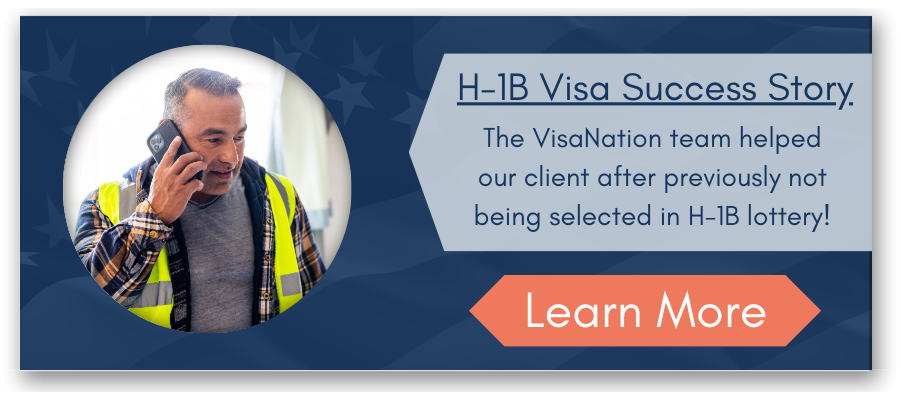Can H-1B Workers Work Remotely? – Requirements
The remote work revolution, spurred on by the COVID-19 pandemic, has reshaped the landscape of work, transforming how businesses operate. The H-1B visa allows U.S. employers to temporarily employ foreign workers in specialty occupations that require specialized knowledge. But can H-1B workers work remotely like their American counterparts? The answer is yes — but it’s complicated.
Immigration Attorneys With A Decade of Experience
If you are pursuing a revision of your work visa stipulations, a 20-minute consultation with an immigration attorney can point you in the right direction. VisaNation Law Group has a sterling history of customer satisfaction as we’ve helped thousands navigate the complex and personal world of U.S. Immigration.
Book a Consultation
How to Work Remotely as an H-1B Worker
As an H-1B visa holder, your ability to work remotely boils down to the information found on your Labor Condition Application (LCA). The LCA is the backbone of every H-1B visa. It is the employer’s responsibility to the USCIS that lays out the information about their incoming non-immigrant worker. The LCA contains details about the job, such as:
- Job Title & Role
- Salary
- Duration of Employment
- Location
Traditionally, the H-1B visa requires the foreign worker to be employed at a location specified in the LCA filed by the employer.
The rules state that the employer who submits a LCA needs to mention a place of employment on the file. So, if part of your initial agreement with an employer included a work-from-home policy, as long as it is correctly indicated on the LCA, you are able to work remotely with an H-1B.
However, any changes to these details usually necessitate filing a new or amended LCA, followed potentially by an amended H-1B petition. If you have questions about your individual case, consulting with an immigration attorney may be your best course of action.
H-1B Visa Location Flexibility
The LCA regulations mandate a specific work location, allowing for remote work, but with certain caveats.
Same Metropolitan Area
The Metropolitan Statistical Area (MSA) plays a significant role in determining whether an amended Labor Condition Application (LCA) is required for H-1B workers who change their work location to remote. When the new remote work location falls within the same MSA as the original worksite mentioned in the LCA, the U.S. Department of Labor generally does not require an amended LCA. This offers some flexibility to employers and employees alike, allowing for easier transitions to new work locations within the same geographical area.
Short-Term Placements
According to the short-term placement regulations, U.S. employers can place H-1B workers at new worksites not listed on the LCA and outside of the MSA for up to 30 to 60 days per year, depending on whether the employer has a permanent office at the new worksite. Conditions include:
– The worker must still maintain ties to their “home” worksite (i.e., the worksite listed on the LCA).
– The worker cannot already have another “primary” worksite.
– The employer must continue to pay the prevailing wage based on the LCA’s listed worksite and meet other LCA conditions.
Given the complexity and potential penalties for non-compliance, it is strongly advised that both employers and H-1B workers reach out to immigration attorneys experienced with H-1B regulations when considering any work arrangement that deviates from the original LCA and H-1B petition.
Home Office
If you’re an H-1B worker transitioning to a home office, your home address may need to be listed on the LCA as one of your work locations. This is especially important if the home office is in a different MSA than the employer’s primary worksite. Different MSAs can have different prevailing wages, and your employer must pay you the higher of the prevailing wage or the actual wage paid to similar workers, as required by the LCA.
Will My Wage Change If I Begin Working Remotely?
The concept of the “prevailing wage” is central to the H-1B visa program. It is designed to ensure that foreign workers are not used to undercut wages of U.S. workers in similar roles. Regardless of the work location, H-1B workers must still be paid the prevailing wage as specified in the LCA and must also meet all other terms and conditions of employment. These can include working hours, job responsibilities, and benefits like health insurance, retirement contributions, and paid leave.
Essentially, the employment terms should be such that the H-1B worker is treated at par with U.S. workers in similar roles, so as to not disadvantage the domestic workforce.
Failure to meet this standard could lead to legal penalties for the employer, including fines and potentially the revocation of the visa. If you’re an employee and are concerned about your employer violate these immigrant regulations, seek guidance from an immigration attorney.
Traveling For Work As an H-1B Visa Worker
Navigating the intricacies of the H-1B visa program can be challenging, and traveling for work adds another layer of complexity. Consult an immigration attorney if you are concerned you’re in danger of infringing on any U.S. immigration laws. If you’re an H-1B visa holder and your job requires travel, there are some key points you should consider to ensure you remain in compliance.
Consult With An Immigration Professional
Given the complexity and potential penalties for non-compliance, it is strongly advised that both employers and H-1B workers consult with immigration attorneys experienced with H-1B regulations when considering any work arrangement that deviates from the original LCA and H-1B petition.
Schedule a Call
Domestic Travel for Work
For travel within the United States, the primary concern is maintaining your H-1B status. As long as you maintain your address in the petition, you can stay outside the work location for up to 90 calendar days in a single instance and for as many times as required. Ensure that you’re continuing to comply with the terms of your employment as specified in your LCA and H-1B petition.
International Travel for Work
When journeying outside of the United States as an H-1B visa holder, it’s crucial to have a valid H-1B visa stamp in your passport for re-entry, unless specific exceptions apply. Short trips to Canada or Mexico under particular conditions will not call for the stamp. If your current visa stamp has lapsed, you’ll typically need to obtain a new one from a U.S. consulate either in your home country or a third country. This process might entail waiting periods and possible delays due to administrative processing. Always carry a copy of your H-1B approval notice, which is Form I-797, along with any other pertinent employment paperwork, as you may be asked to show these documents upon your return to the United States.
Conclusion
In conclusion, H-1B workers can work remotely, if they adhere to the proper regulations. Employers and employees alike must be proactive in ensuring that all conditions are met when an H-1B employee shifts to remote work. As the remote work landscape evolves, the regulations will continue to adapt to accommodate the way we work in the United States. By staying well-informed, and leaning on practicing immigration lawyers, you can help ensure that where you work does not adversely affect your H-1B status.





